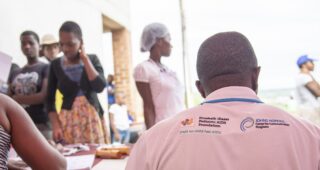Expert Opinion: The First Real Prevention Is Keeping Children HIV-free
You are here

Our “Expert Opinion” blog series highlights the perspectives of researchers, doctors, and other specialists working to end AIDS in children.
Nick Hellmann, M.D. has worked on the front lines in the battle against HIV/AIDS since the early 1980s. With the number of new infections in children decreasing worldwide, he says finally ending the pandemic will require research toward a vaccine, stronger health systems, and improved maternal and child health worldwide.
I am trained as a physician specializing in infectious diseases. I started my postgraduate experience in San Francisco in 1982, when the AIDS epidemic was still very young. It was pretty grim.
Then in 1988, I went to work in Uganda. In a sense, it was moving from the frying pan to the fire. Things were bad in San Francisco, but they were much worse in Africa.
One of my most vivid recollections when we first arrived in Uganda was taking the drive from Entebbe into Kampala. I remember seeing all these shops on the side of the road especially as you got closer to Kampala. If you can imagine, the single largest growth industry in Uganda when we arrived in 1988 was coffin making. You just saw all these little shops with stacks of caskets there. During our first year in the sexually transmitted diseases clinic, one out of two people who walked through the door of the clinic were HIV positive.
It’s telling that when you go there now, you don’t see much casket making. The number of women who have access to prevention of mother-to-child transmission of HIV (PMTCT) services has skyrocketed, so the number of new infections in children is decreasing incredibly.
A Vaccine and a Cure
EGPAF has a big role to play in pushing the agenda forward, not only for the sake of children but also to help point the way to potentially big benefits for adults. The nuances of a child’s immune system may permit us to identify a protective vaccine in children before we do in adults.
Even though we changed AIDS from being a uniformly lethal disease to a manageable chronic disease—and people can live long, productive lives with it—the bottom line is that health care workers still need to treat people for life with complex and somewhat toxic therapies. And AIDS is still is a disease that causes significant morbidity, so we still desperately need a vaccine and/or a cure to truly end the scourge of AIDS.
And vaccines may also be used therapeutically to reduce the impact of the virus on people who are infected.
We also need to continue to push hard at eradicating the virus in people who are already infected—because even if tomorrow I could wave a magic wand and have a vaccine that could prevent all new infections, there are currently still about 35 million people in the world living with HIV.
Strengthening Health Systems
Everyone knows EGPAF very well because of our successful efforts to scale up PMTCT—especially in sub-Saharan Africa. We really have also been from the very earliest stages one of the largest implementers of HIV care and treatment. If a cost-effective and cost-appropriate curative or vaccine intervention could be implemented, we would be a prime candidate to manage it because we have the structure, we know how to support the programs and work with the national and local agencies, we know how to integrate programs into existing health systems, and we know how to strengthen health systems.
Remember that there is no such thing as an HIV health system. Health systems throughout the world do not deal with individual diseases; they deal with patients or clients. Sustainable systems and programs to eradicate HIV have to be integrated within existing health systems.
Maternal and Child Health
Most of the work we do is related to maternal, child, and reproductive health. So we have to continue to focus on strengthening those systems.
As part of that, we have to build more capacity in the countries where we work, building up local organizations. We have to continue to reach out to communities and make sure that they are engaged with maternal and child health services—and those families are retained within those services over time.
Elizabeth Glaser was instrumental in putting children on the map and, subsequently, the benefits that have been derived for children during this epidemic have been fantastic. People still forget the first major HIV prevention success in any population was the prevention of new infections in children.
Nicholas Hellmann, M.D., is EGPAF’s strategy and science advisor and the former executive vice president for Medical and Scientific Affairs.
Nicholas Hellmann, M.D.
General



